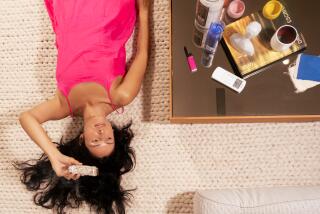China women go in for Western features
- Share via
Reporting from Shanghai — He Zen’s path to cosmetic surgery was fast and simple.
Her mother saw an ad in a Shanghai newspaper and figured that more Caucasian-looking eyes would make it easier for her unmarried 28-year-old daughter to find a husband. She made an appointment for her daughter the next Saturday morning. When He Zen went to the clinic and saw some examples of the doctor’s work, she agreed to have the $290 operation that afternoon.
Shortly after enduring the two-week recovery period, she got what she’d been after: not an offer of marriage, but the offer of a coveted internship with the Shanghai office of the British banking giant HSBC, which later led to a full-time job.
“A lot of people think it’s not very good politics — a kind of scandal — to have these kinds of small procedures,” said He Zen, a petite, confident woman who’s now an HSBC manager. “I wouldn’t tell anybody. Nobody knows.”
She’s one of thousands of young Chinese women choosing to have eyelid reconstruction, nasal bridge augmentation or breast enlargements in hopes of improving their chances of finding mates, getting better jobs or both. An increasing number of men are also opting for surgical change.
Young adults in cosmopolitan cities such as Shanghai have grown up surrounded by images of beautiful women with Western features. Rail passengers are surrounded by posters of wide-eyed supermodels, and larger-than-life billboards for the Zara and H&M clothing stores line the streets of Shanghai’s upscale Pudong district. In the Shanghai shop that sells Barbie dolls, workers acknowledge that Caucasian Barbies sell well, but dolls with Asian features “just sit on the shelves.”
It’s no wonder, then, that by the time women in China reach their 20s, a goodly number are seriously considering cosmetic surgery, and the explosion of wealth in China has put it within reach of many of them.
Shanghai’s New Generation Cosmetic Surgery Hospital, whose website advertises procedures such as “abdominal liposuction to end your beer belly” and “mandible angle plastic: farewell to square face malformation,” made headlines in February for agreeing to perform cosmetic surgery on a 21-year-old woman who hoped to get back together with her boyfriend by looking more like American actress Jessica Alba.
Yang Yunxia, the director of New Generation’s cosmetic surgery unit and a cosmetic surgeon for 20 years, said she and her team performed about 40,000 procedures a year, often for women who complained about “disfigurations” such as the inability to open their eyes wide or the lack of a nasal bridge.
“Big eyes and a straight bridge are signs of beauty,” Yang said. “Ladies don’t like their face to be big and fat, so they want to change their face into a more beautiful shape.”
The cost of going under Yang’s knife ranges from $290 for eyelid reconstruction to $7,300 for breast implants, and the operations aren’t without risk. Industry reports say that over the last decade, at least 200,000 lawsuits have been filed in China for disfiguration after faulty cosmetic procedures, many of which take place in small clinics similar to the one He Zen visited.
He Zen is one of the lucky ones. She had a seamless procedure that could pass for natural beauty, but Yang said many of the procedures she performed at New Generation were correctional operations after surgeries gone wrong.
“It happens a lot of times. Patients come with one big eye and one small eye or uneven breasts,” Yang said. “China is a big place with lots of different standards.”
No matter how many botched procedures are reported in China, the desire for Western-looking features such as wide eyes or large breasts continues.
Mattel Inc., the U.S. toy company that makes Barbie dolls, chose Shanghai for its flagship Barbie store in China last year. General Manager Dann Murphy, who’s from New York and who left a position at Mattel in Los Angeles to come to Shanghai, was candid about the store’s marketing strategy.
“We don’t offer a lot of Asian Barbies because they never sell well,” Murphy said. “Customers like to buy the authentic Barbie that they think is beautiful, and Barbie is known to have blond hair and blue eyes.”
Murphy said the store sold special Barbies, such as the Shanghai Lynn Barbie, for Chinese holidays; however, he said, these dolls don’t sell as well as the Western-looking dolls do.
Victoria Wang, a 28-year-old who adopted a Western name, another growing trend in Asian culture, is a frequent shopper at Sephora, a popular source of Western beauty products in Shanghai. She said she bought “almost every brand” in the store.
“I try to imitate the models in magazines,” said Wang, who reads Elle and the Japanese fashion magazines Ray and Lee.
Valerie Monroe, the beauty director at O, The Oprah Magazine, said the rising trend in Western-looking cosmetic procedures was the result of a “growth in global communication” that was exposing women worldwide to American and European beauty ideals.
“Now it’s possible for girls in China to see our cultural icons for beauty,” Monroe said. “If they’re being exposed to the Western version of what beauty is supposed to be like, they might want to emulate it.”
“If all the media show are very thin blond-haired blue-eyed women, they’ll try to emulate that,” said Monroe, who added that O’s philosophy is to “celebrate your assets” and “not submit to a cultural ideal.”
Tomb, a graduate of Penn State University, reported this story from Shanghai for a class in international journalism.
More to Read
Sign up for Essential California
The most important California stories and recommendations in your inbox every morning.
You may occasionally receive promotional content from the Los Angeles Times.













